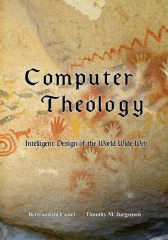PRESS
COMPUTER THEOLOGY |
||||
|
short section of molecule that is generally perceived to be
related to the production of a specific protein. If we think of these distinct
segments as illustrative of contexts, then there is a very strong parallel to
computer memory. While at its most basic, computer memory appears as a string
of individually addressable words filled with bits, in fact we can layer a much
more complex information organization on top of this. For example, by
designating a section of memory to the task of defining further subsections,
where they start, their extent and some general way to refer to them, then we
can create a file system on top of a linear
memory structure. The files give us the first level of decomposition into
discrete contexts. We can make the various contexts even more specific by not
only organizing the way that we reference memory, but by assigning specific
procedures in the form of distinct sets of computer code to interpret specific
segments of memory. Consider, for example the recording of music within the
domain of a computer. Music is a
complex rendition of sounds that are conveyed from source to destination by way
of acoustic waves that propagate through various materials. The sensori-motor
experience of a computer central processing unit does not encompass sound; it
encompasses words containing bits. Consequently, to remember music, a computer
needs to detect the acoustic wave form and to translate this into the
sensori-motor representation form of a central processing unit by digitally
sampling the acoustic waveforms of music, and by doing this, create a stream of
words and bits that can be stored in a mechanical device through an
electromagnetic based process. When these words and bits are retrieved, the
context of the original music must also be retrieved and reestablished, thus
allowing, through translation, the bit streams to be re-cast as acoustic
waveforms emanating from a speaker. Now, we hear once again the original music.
In a similar fashion, a series of words and bits can be recorded that derive
from visual images. The mechanisms
through which computers store information, including sets of instructions that
tell the central processing unit of the computer what to do with that
information, are termed memories. We use plural of the term advisedly in that
there are several memory technologies, which offer different characteristics to
the overall computer architecture. From an historical perspective, memory has
been a major area of evolution of electronic computer systems since their
inception in the 1940’s. Variants for computer memory that we can introduce
now, but which we’ll explore in more detail in later sections, are, among
others: read-only memory, random access memory and bulk memory such as disk
drives and magnetic tape. We have noted
that just about all computers today have a so-called Von Neumann architecture,
where instructions and data are contained in memory, and a processing unit
reads the instructions and executes them on the data. Computers also have input/output channels that give them
access to the outside world. Each channel typically has its own processing
capabilities, dedicated to the management of the flow of information in and out
of the computer through that channel. Let us consider three examples. A print channel allows sending information from the computer to a printer. It is essentially an output channel, since the main flow of data goes from the computer to the external device. However, it is also an input channel because the printer may send data back to the computer, for example a signal indicating that it doesn’t have any more paper. A small unit of processing capability links the computer and the printer and manages the flow of data and signals, moving information between the memory of the computer and the memory of the printer when the signals show readiness. One equivalent of the printing example by computers might be singing by humans. In singing, the main flow of information within the singer goes from the brain to the buccal system, which itself governs the various anatomical maneuvers that lead to the expression of the song. A feedback system is capable of signaling, for example, an echo, or other acoustic |
||||
|
||||
© Midori Press, LLC, 2008. All rights reserved for all countries. (Inquiries) The contents of ComputerTheology: Intelligent Design of the World Wide Web are presented for the sole purpose of on-line reading to allow the reader to determine whether to purchase the book. Reproduction and other derivative works are expressly forbidden without the written consent of Midori Press. Legal deposit with the US Library of Congress 1-33735636, 2007.
|
ComputerTheology Intelligent Design of the World Wide Web Bertrand du Castel and Timothy M. Jurgensen Midori Press, Austin Texas 1st Edition 2008 (468 pp) ISBN 0-9801821-1-5 |
Book available at Midori Press (regular) |
